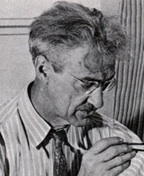William Bushnell Stout (1880-1956)
U.S. automotive and aeronautical designer who was born in Quincy, Illinois, and attended Hamline University and the University of Minnesota. He founded the Model Aero Club of Illinois. In 1909 he worked as a tracer in the drafting room for the Schurmeier Motor Truck Company until it went bankrupt in 1912. Then he became automobile and aviation editor of the Chicago Tribune, as well as founder of the first aviation magazine published in the U.S., Aerial Age. In 1914 he became Chief Engineer for the Scripps-Booth Auto Company, whose new car he designed.
In 1916 he was general sales manager for the Packard Motor Company, and when it started an aviation division, he became its first chief engineer. In 1917 he became an advisor to the National Aircraft Board in Washington, D.C. In Dearborn, MI, he founded the Stout Engineering Laboratories in 1919. He began experimenting with all-metal aircraft in 1923, founding the Stout Metal Airplane Company, which in 1924 was bought by the Ford Motor Company. Stout soon developed the first all-metal plane, the 3-engine Stout 3-AT, which was modified to become the Ford Tri-motor in 1925. That year, he started Stout Air Services, which operated the first regularly scheduled airline in the U.S. In 1932 he began to operate the Stout Research Division of Consolidated Vultee Aircraft Corporation.
He developed an experimental Railplane for Pullman in 1934, a 50-passenger railcar with tubular frame that looked like an airplane. It was 1/10th the weight of a normal steel coach, and was exhibited at the 1933-1934 Century of Progress Exposition in Chicago. Stout also collaborated on the Union Pacific’s M-10000 train. In 1934, he founded the Stout Motor Car Company, and introduced the Scarab car in 1935. The beetle-like Scarab, probably the first mini-van, looked like a long Volkswagen beetle limosine, with an all-aluminum tubular airframe covered with an aluminum skin, and with the engine compartment in the rear. The front or nose contained a spare tire. Only nine were built, as the public never appreciated the advanced design.
Stout developed four airplane/automobile Skycar concepts from 1931 through 1944. Skycar I was displayed at the 1931 Detroit Show, was used by Stout as a personal airplane. It was later donated to the Smithsonian Institution, and is on display at the National Air and Space Museum. It was a two-seat high-wing monoplane. Skycar II was a higher-powered version in 1941, with stainless steel construction and twin tail booms. Skycar III in 1943 was similar but with a higher power engine, and was tested by the U.S. Army Air Force as the XC-107. Skycar IV in 1944 was also known as the Convair 103, with twin tail fins and rudders.

